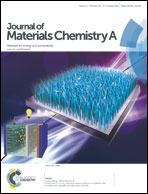Hematite iron oxide nanorod patterning inside COK-12 mesochannels as an efficient visible light photocatalyst†
Abstract
The uniform dispersion of functional oxide nanoparticles inside ordered mesoporous silica to tailor optical, electronic, and magnetic properties for biomedical and environmental applications is a scientific challenge. Herein, we demonstrate for the very first time the morphological effect of platelet-driven confined growth of hematite iron oxide (α-Fe2O3) nanorods inside the mesochannels of ordered mesoporous silica COK-12 material denoted as α-Fe2O3@COK-12. The inclusion of the α-Fe2O3 nanorods in COK-12 particles is studied in detail using high-angle annular dark field scanning transmission electron microscopy (HAADF-STEM), energy-dispersive X-ray (EDX) spectroscopy and electron tomography. High resolution imaging and EDX spectroscopy provide information about the particle size, shape and crystal phase of the loaded α-Fe2O3 material, while electron tomography provides detailed information on the spreading of the nanorods throughout the COK-12 host in three-dimension. This nanocomposite material, having a semiconductor band gap energy of 2.50 eV according to diffuse reflectance spectroscopy, demonstrates an improved visible light photocatalytic degradation activity with rhodamine 6G and 1-adamantanol model compounds.


 Please wait while we load your content...
Please wait while we load your content...